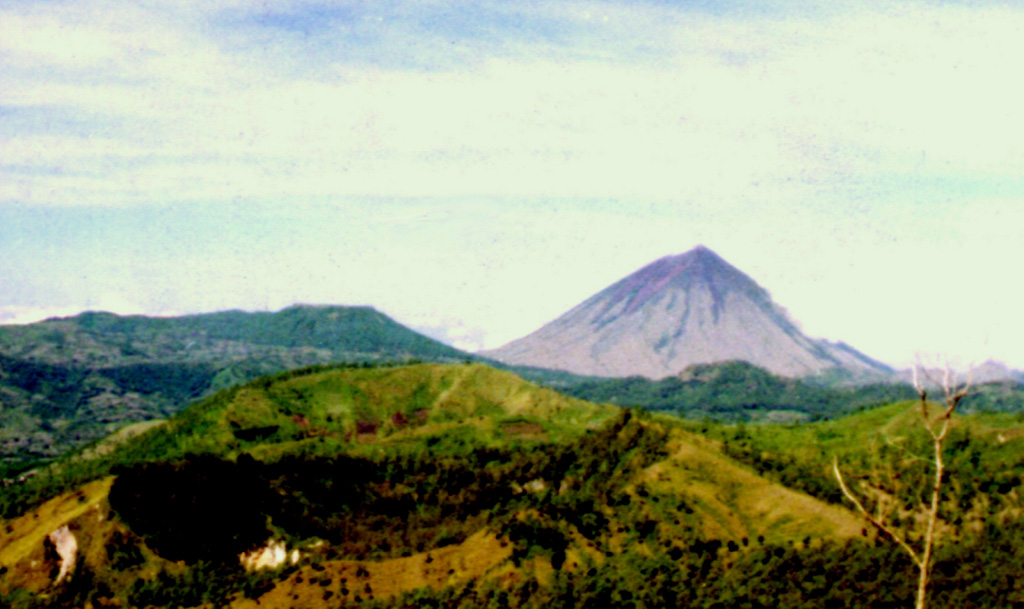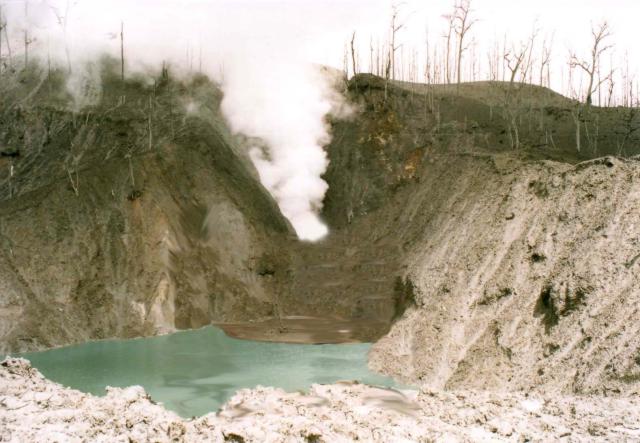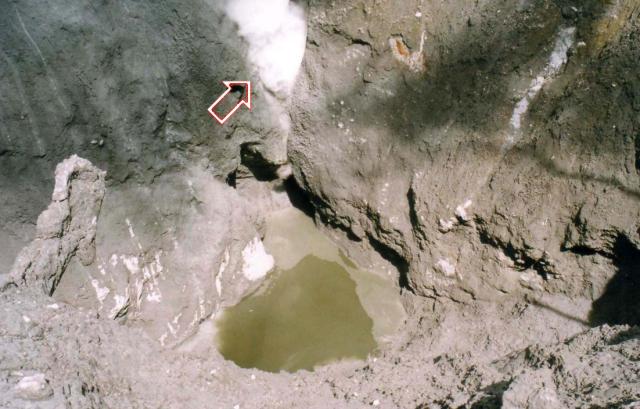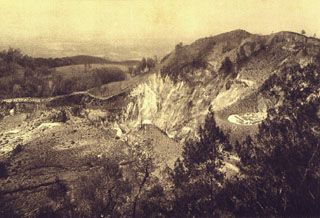

PVMBG lowered the Alert Level for Inielika to 1 (on a scale of 1-4) at 1100 on 16 March, noting that unrest had decreased based on visual observations, seismicity, and geochemistry data. The public was warned to stay at least 500 m away from the summit crater and to avoid solfatara zones and hot springs.
Source: Pusat Vulkanologi dan Mitigasi Bencana Geologi (PVMBG, also known as CVGHM)
Small February-March 2001 ash plumes and generally low seismicity
Since the decline in eruptive activity that occurred during 23 January-5 February 2001 (BGVN 26:01), variable seismicity has prevailed. Ash plumes were observed in February and March reaching 10-500 m above the volcano. The Volcanological Survey of Indonesia (VSI) reported varying amounts of seismicity (table 1). VSI has not reported new eruptive activity at Inielika since May 2001.
Table 1. Seismic activity detected at Inielika during February through May 2001. Courtesy of VSI.
| Date | Deep volcanic (A-type) | Shallow volcanic (B-type) | Tectonic |
| 06 Feb-11 Feb 2001 | 23 | 7 | 10 |
| 20 Feb-26 Feb 2001 | 34 | 15 | 32 |
| 27 Feb-05 Mar 2001 | 57 | 19 | 51 |
| 06 Mar-12 Mar 2001 | 30 | 6 | 18 |
| 12 Mar-18 Mar 2001 | 4 | 1 | 13 |
| 19 Mar-23 Mar 2001 | 3 | -- | 9 |
| 27 Mar-01 Apr 2001 | 6 | -- | -- |
| 02 Apr-08 Apr 2001 | 4 | -- | 11 |
| 09 Apr-15 Apr 2001 | 7 | 4 | 6 |
| 16 Apr-23 Apr 2001 | 5 | 10 | 11 |
| 25 Apr-01 May 2001 | 5 | 10 | 11 |
Information Contacts: Dali Ahmad, Volcanological Survey of Indonesia (VSI), Jalan Diponegoro No. 57, Bandung 40122, Indonesia (URL: http://www.vsi.esdm.go.id/).
2024: March
2023: October
2001: January
| February
| April
PVMBG lowered the Alert Level for Inielika to 1 (on a scale of 1-4) at 1100 on 16 March, noting that unrest had decreased based on visual observations, seismicity, and geochemistry data. The public was warned to stay at least 500 m away from the summit crater and to avoid solfatara zones and hot springs.
Source: Pusat Vulkanologi dan Mitigasi Bencana Geologi (PVMBG, also known as CVGHM)
PVMBG reported that seismicity at Inielika generally consisted of low levels of low-frequency earthquakes and 0-1 daily deep volcanic earthquakes. Seismicity began to increase on 29 September and remained elevated at least through 4 October. The daily number of deep volcanic earthquakes increased to an average of 9, though notably a total of 17 were recorded on 1 October and 18 were recorded on 3 October. The temperatures and gas concentrations at four hot spring locations had significantly decreased compared to July measurements. The Alert Level was raised to 2 (on a scale of 1-4) at 1000 on 4 October due to increased potential for a phreatic eruption; the public was warned to stay at least 1 km away from the summit crater and to stay away from solfatara zones.
Source: Pusat Vulkanologi dan Mitigasi Bencana Geologi (PVMBG, also known as CVGHM)
VSI reported that during 16-23 April seismic activity increased at Inielika in comparison to the previous week. Seismographs recorded five deep volcanic, ten shallow volcanic, and eleven tectonic earthquakes. Inielika is at Alert Level 2 (on a scale of 1-4). The previous report of significant volcanic activity occurred on 11 January 2001 when minor explosions began.
Source: Pusat Vulkanologi dan Mitigasi Bencana Geologi (PVMBG, also known as CVGHM)
During 6-11 February, Inielika volcano remained active and the VSI reported no significant change in volcanic activity. An ash plume was observed rising 25-500 m above the volcano and there was a slight increase in the number of deep volcanic earthquakes in comparison to the previous week. The Alert Level at the volcano was reduced from 3 to 2 (on a scale of 1-4).
Source: Pusat Vulkanologi dan Mitigasi Bencana Geologi (PVMBG, also known as CVGHM)
The VSI reported that during 23-29 January no explosive activity occurred, but a plume of white ash rose 100-500 m above the crater. The volcano remained at Alert Level 3 (on a scale of 1-4).
Source: Pusat Vulkanologi dan Mitigasi Bencana Geologi (PVMBG, also known as CVGHM)
The VSI reported that during 16-22 January ongoing explosions sent ash 100-1,000 m above the crater rim. Ash was deposited within a 10-20 m radius around the crater; lapilli with a maximum diameter of 50 cm were deposited out to ~500 m around the crater. Observations on 21 January revealed that two new large craters formed, to the SE and the NW. The SE crater was 50 m in diameter and 10 m deep. The NW crater was 20 m in diameter, open to the NW, and 1.1 m deep. The volcano remained at Alert Level 3 (on a scale of 1-4).
Source: Pusat Vulkanologi dan Mitigasi Bencana Geologi (PVMBG, also known as CVGHM)
A minor explosion on 11 January 2001 at 1915 produced an ashfall deposit less than 0.5 mm thick in Bajawa (~8 km from the source). On 13 January 2001 at 0700 three explosions occurred, sending a plume ~300-1,000 m above the crater rim; it moved eastward towards Toa village and southward towards Boya village, Bajawa, and Bolodio city. Thundering sounds were heard from the observatory (~7.5 km from the summit). Continuous tremor was recorded with an amplitude of 2 mm and 59 explosion earthquake events had been registered as of 15 January. Inielika is at Alert Level 3 (on a scale of 1-4).
Source: Pusat Vulkanologi dan Mitigasi Bencana Geologi (PVMBG, also known as CVGHM)
Reports are organized chronologically and indexed below by Month/Year (Publication Volume:Number), and include a one-line summary. Click on the index link or scroll down to read the reports.
Explosions eject tephra in first eruption since 1905
A minor explosion occurred at 1915 on 11 January 2001. The explosion ejected ash that coated Bajawa (~8 km from the summit) with an ash layer less than 0.5 mm thick. Increased activity after 11 January prompted the VSI to set the volcano's hazard status to 3 (on a scale of 1-4). Three explosions occurred at about 0700 on 13 January, sending ash 300-1,000 m above the crater rim. Workers at the volcano's observatory post, located ~7.5 km from the summit, subsequently heard thundering sounds. Ash, which appeared dense and light in color, blew E to Toa and S to Boya, Bolodio, and Bajawa. By 15 January, a seismograph recorded continuous tremor with an amplitude of 2 mm in addition to 59 explosion earthquakes with amplitudes of 2-14 mm.
Ash emission was ongoing as of 16 January, and ranged from 100 to 1,000 m above the summit. VSI workers observed two new large craters trending SE-NW. The top of the SE crater measured 50 m in diameter, narrowed to 25 m at its base, and was 10 m deep. It emitted an audible sound and ejected an ash plume from its N wall with variable pressure. Winds tended to blow ash toward the S. The NW crater was 20 m in diameter and 1.1 m deep. The temperature of a fumarole measured 95°C, and nearby ground temperature measured 89°C.
During 16-22 January, explosions produced both ash and lapilli. Light gray ash fell around the main crater within a 10-20 m radius. Lapilli, which had a maximum size of 50 cm, fell up to 500 m from the main crater.
Information Contacts: Dali Ahmad, Volcanological Survey of Indonesia (VSI), Jalan Diponegoro No. 57, Bandung 40122, Indonesia (URL: http://www.vsi.esdm.go.id/).
Explosive activity declines; new images of the summit area
The following report covers Inielika's activity during 23 January-5 February 2001. The VSI issued three photographs showing Inielika's summit area (figures 1-3). No explosions occurred during 23-29 January, unlike earlier in the month (BGVN 25:12). Instead, a white gas-and-steam plume rose 100-500 m above the summit. Volcanic earthquakes, tectonic earthquakes, and continuous tremor with amplitudes varying from 0.3 to 1.2 mm occurred.
 |
Figure 1. A gas-and-steam plume exiting from one of Inielika's craters on 11 January 2001. Courtesy of VSI. |
 |
Figure 3. A recently formed vent (arrow) seen in a crater on Inielika's summit on 11 January 2001. Courtesy of VSI. |
Activity remained relatively similar during the following week of 30 January-5 February. A gas-and-steam plume rose 25-500 m above the summit. The number of deep volcanic (A-type) earthquakes increased with respect to the previous week, and tremor was no longer continuous. The VSI maintained Inielika's hazard status at Level 3 (on a scale of 1-4) as of 5 February.
Information Contacts: Dali Ahmad, Volcanological Survey of Indonesia (VSI), Jalan Diponegoro No. 57, Bandung 40122, Indonesia (URL: http://www.vsi.esdm.go.id/).
Small February-March 2001 ash plumes and generally low seismicity
Since the decline in eruptive activity that occurred during 23 January-5 February 2001 (BGVN 26:01), variable seismicity has prevailed. Ash plumes were observed in February and March reaching 10-500 m above the volcano. The Volcanological Survey of Indonesia (VSI) reported varying amounts of seismicity (table 1). VSI has not reported new eruptive activity at Inielika since May 2001.
Table 1. Seismic activity detected at Inielika during February through May 2001. Courtesy of VSI.
| Date | Deep volcanic (A-type) | Shallow volcanic (B-type) | Tectonic |
| 06 Feb-11 Feb 2001 | 23 | 7 | 10 |
| 20 Feb-26 Feb 2001 | 34 | 15 | 32 |
| 27 Feb-05 Mar 2001 | 57 | 19 | 51 |
| 06 Mar-12 Mar 2001 | 30 | 6 | 18 |
| 12 Mar-18 Mar 2001 | 4 | 1 | 13 |
| 19 Mar-23 Mar 2001 | 3 | -- | 9 |
| 27 Mar-01 Apr 2001 | 6 | -- | -- |
| 02 Apr-08 Apr 2001 | 4 | -- | 11 |
| 09 Apr-15 Apr 2001 | 7 | 4 | 6 |
| 16 Apr-23 Apr 2001 | 5 | 10 | 11 |
| 25 Apr-01 May 2001 | 5 | 10 | 11 |
Information Contacts: Dali Ahmad, Volcanological Survey of Indonesia (VSI), Jalan Diponegoro No. 57, Bandung 40122, Indonesia (URL: http://www.vsi.esdm.go.id/).
|
|
||||||||||||||||||||||||||
There is data available for 2 confirmed eruptive periods.
2001 Jan 11 - 2001 Mar 16 (?) ± 15 days Confirmed Eruption (Explosive / Effusive) VEI: 2
| Episode 1 | Eruption (Explosive / Effusive) | Summit crater complex | |||||||||||||||||||||||||||||||||
|---|---|---|---|---|---|---|---|---|---|---|---|---|---|---|---|---|---|---|---|---|---|---|---|---|---|---|---|---|---|---|---|---|---|---|
| 2001 Jan 11 - 2001 Mar 16 (?) ± 15 days | Evidence from Observations: Reported | |||||||||||||||||||||||||||||||||
|
List of 5 Events for Episode 1 at Summit crater complex
|
||||||||||||||||||||||||||||||||||
1905 Nov - 1905 Nov Confirmed Eruption (Explosive / Effusive) VEI: 2
| Episode 1 | Eruption (Explosive / Effusive) | |||||||||||||||||||||||||||||
|---|---|---|---|---|---|---|---|---|---|---|---|---|---|---|---|---|---|---|---|---|---|---|---|---|---|---|---|---|---|
| 1905 Nov - 1905 Nov | Evidence from Observations: Reported | ||||||||||||||||||||||||||||
|
List of 4 Events for Episode 1
|
|||||||||||||||||||||||||||||
This compilation of synonyms and subsidiary features may not be comprehensive. Features are organized into four major categories: Cones, Craters, Domes, and Thermal Features. Synonyms of features appear indented below the primary name. In some cases additional feature type, elevation, or location details are provided.
Synonyms |
||||
| Inie Lika | Wawolika | ||||
Cones |
||||
| Feature Name | Feature Type | Elevation | Latitude | Longitude |
| Inegena, Wolo | Cone | 1798 m | 8° 42' 51.00" S | 120° 58' 33.00" E |
| Lebijaga, Wolo | Cone - Crater | 1376 m | 8° 46' 36.00" S | 120° 58' 27.00" E |
Craters |
||||
| Feature Name | Feature Type | Elevation | Latitude | Longitude |
| Boki, Wolo
Bugi, Wolo |
Crater | 1425 m | 8° 46' 0.00" S | 120° 57' 48.00" E |
| Inielika, Wolo | Crater | 1750 m | 8° 43' 23.00" S | 120° 58' 21.00" E |
| Lega, Wolo | Crater | 1513 m | 8° 45' 10.00" S | 120° 57' 57.00" E |
| Lobobutu | Pleistocene caldera | 1835 m | 8° 44' 19.00" S | 120° 55' 55.00" E |
| Loboleke, Wolo | Crater | 1296 m | 8° 46' 6.00" S | 120° 58' 51.00" E |
| Pipidodo, Wolo | Crater | 1280 m | 8° 47' 33.00" S | 120° 58' 41.00" E |
| Runu, Wolo | Crater | 1556 m | 8° 45' 27.00" S | 120° 58' 33.00" E |
| Wawomuda, Wolo | Crater | 1450 m | 8° 44' 25.00" S | 120° 58' 34.00" E |
 This view from the east shows the N-S-trending crater complex of Inielika volcano. At the far left is Wolo Lega crater, and the 1905 crater is located just right of center. The high point at the center of the photo is Wawolika cone.
This view from the east shows the N-S-trending crater complex of Inielika volcano. At the far left is Wolo Lega crater, and the 1905 crater is located just right of center. The high point at the center of the photo is Wawolika cone. The Inielika chain of cones and craters stretches across the central highlands of Flores Island at right in this view from the NE. The peak at left center is Gunung Inierie volcano, the highest on the island. On the far left horizon is Wolo Bobo, a feature of the Bajawa cinder cone complex. The high irregular peak on the right horizon is part of the Lobobutu caldera wall, with various Inielika craters in the foreground.
The Inielika chain of cones and craters stretches across the central highlands of Flores Island at right in this view from the NE. The peak at left center is Gunung Inierie volcano, the highest on the island. On the far left horizon is Wolo Bobo, a feature of the Bajawa cinder cone complex. The high irregular peak on the right horizon is part of the Lobobutu caldera wall, with various Inielika craters in the foreground. A brief phreatic eruption in November 1905 lasting 5 hours formed this crater at Inielika volcano. The 125-m-wide crater formed on the floor of Wolo Inielika crater, one of many craters along a N-S-trending ridge.
A brief phreatic eruption in November 1905 lasting 5 hours formed this crater at Inielika volcano. The 125-m-wide crater formed on the floor of Wolo Inielika crater, one of many craters along a N-S-trending ridge. A N-S-trending chain of cones and craters in the central highlands forms the summit of Inielika volcano, seen here from the east. Ten craters, some of which contain crater lakes, occur across the complex summit region and others occupy the flanks. A phreatic explosion in 1905 formed a new crater.
A N-S-trending chain of cones and craters in the central highlands forms the summit of Inielika volcano, seen here from the east. Ten craters, some of which contain crater lakes, occur across the complex summit region and others occupy the flanks. A phreatic explosion in 1905 formed a new crater. Two of the many summit craters of Inielika can be seen in the left foreground. It is a broad, low volcano in central Flores Island that was constructed within the Lobobutu caldera. The complex summit includes ten craters, some of which contain lakes. A phreatic explosion that formed a new crater in 1905 was the volcano's only eruption during the 20th century. Inierie volcano is the prominent peak on the right horizon.
Two of the many summit craters of Inielika can be seen in the left foreground. It is a broad, low volcano in central Flores Island that was constructed within the Lobobutu caldera. The complex summit includes ten craters, some of which contain lakes. A phreatic explosion that formed a new crater in 1905 was the volcano's only eruption during the 20th century. Inierie volcano is the prominent peak on the right horizon.There are no samples for Inielika in the Smithsonian's NMNH Department of Mineral Sciences Rock and Ore collection.
| Copernicus Browser | The Copernicus Browser replaced the Sentinel Hub Playground browser in 2023, to provide access to Earth observation archives from the Copernicus Data Space Ecosystem, the main distribution platform for data from the EU Copernicus missions. |
| MIROVA | Middle InfraRed Observation of Volcanic Activity (MIROVA) is a near real time volcanic hot-spot detection system based on the analysis of MODIS (Moderate Resolution Imaging Spectroradiometer) data. In particular, MIROVA uses the Middle InfraRed Radiation (MIR), measured over target volcanoes, in order to detect, locate and measure the heat radiation sourced from volcanic activity. |
| MODVOLC Thermal Alerts | Using infrared satellite Moderate Resolution Imaging Spectroradiometer (MODIS) data, scientists at the Hawai'i Institute of Geophysics and Planetology, University of Hawai'i, developed an automated system called MODVOLC to map thermal hot-spots in near real time. For each MODIS image, the algorithm automatically scans each 1 km pixel within it to check for high-temperature hot-spots. When one is found the date, time, location, and intensity are recorded. MODIS looks at every square km of the Earth every 48 hours, once during the day and once during the night, and the presence of two MODIS sensors in space allows at least four hot-spot observations every two days. Each day updated global maps are compiled to display the locations of all hot spots detected in the previous 24 hours. There is a drop-down list with volcano names which allow users to 'zoom-in' and examine the distribution of hot-spots at a variety of spatial scales. |
|
WOVOdat
Single Volcano View Temporal Evolution of Unrest Side by Side Volcanoes |
WOVOdat is a database of volcanic unrest; instrumentally and visually recorded changes in seismicity, ground deformation, gas emission, and other parameters from their normal baselines. It is sponsored by the World Organization of Volcano Observatories (WOVO) and presently hosted at the Earth Observatory of Singapore.
GVMID Data on Volcano Monitoring Infrastructure The Global Volcano Monitoring Infrastructure Database GVMID, is aimed at documenting and improving capabilities of volcano monitoring from the ground and space. GVMID should provide a snapshot and baseline view of the techniques and instrumentation that are in place at various volcanoes, which can be use by volcano observatories as reference to setup new monitoring system or improving networks at a specific volcano. These data will allow identification of what monitoring gaps exist, which can be then targeted by remote sensing infrastructure and future instrument deployments. |
| Volcanic Hazard Maps | The IAVCEI Commission on Volcanic Hazards and Risk has a Volcanic Hazard Maps database designed to serve as a resource for hazard mappers (or other interested parties) to explore how common issues in hazard map development have been addressed at different volcanoes, in different countries, for different hazards, and for different intended audiences. In addition to the comprehensive, searchable Volcanic Hazard Maps Database, this website contains information about diversity of volcanic hazard maps, illustrated using examples from the database. This site is for educational purposes related to volcanic hazard maps. Hazard maps found on this website should not be used for emergency purposes. For the most recent, official hazard map for a particular volcano, please seek out the proper institutional authorities on the matter. |
| IRIS seismic stations/networks | Incorporated Research Institutions for Seismology (IRIS) Data Services map showing the location of seismic stations from all available networks (permanent or temporary) within a radius of 0.18° (about 20 km at mid-latitudes) from the given location of Inielika. Users can customize a variety of filters and options in the left panel. Note that if there are no stations are known the map will default to show the entire world with a "No data matched request" error notice. |
| UNAVCO GPS/GNSS stations | Geodetic Data Services map from UNAVCO showing the location of GPS/GNSS stations from all available networks (permanent or temporary) within a radius of 20 km from the given location of Inielika. Users can customize the data search based on station or network names, location, and time window. Requires Adobe Flash Player. |
| DECADE Data | The DECADE portal, still in the developmental stage, serves as an example of the proposed interoperability between The Smithsonian Institution's Global Volcanism Program, the Mapping Gas Emissions (MaGa) Database, and the EarthChem Geochemical Portal. The Deep Earth Carbon Degassing (DECADE) initiative seeks to use new and established technologies to determine accurate global fluxes of volcanic CO2 to the atmosphere, but installing CO2 monitoring networks on 20 of the world's 150 most actively degassing volcanoes. The group uses related laboratory-based studies (direct gas sampling and analysis, melt inclusions) to provide new data for direct degassing of deep earth carbon to the atmosphere. |
| Large Eruptions of Inielika | Information about large Quaternary eruptions (VEI >= 4) is cataloged in the Large Magnitude Explosive Volcanic Eruptions (LaMEVE) database of the Volcano Global Risk Identification and Analysis Project (VOGRIPA). |
| EarthChem | EarthChem develops and maintains databases, software, and services that support the preservation, discovery, access and analysis of geochemical data, and facilitate their integration with the broad array of other available earth science parameters. EarthChem is operated by a joint team of disciplinary scientists, data scientists, data managers and information technology developers who are part of the NSF-funded data facility Integrated Earth Data Applications (IEDA). IEDA is a collaborative effort of EarthChem and the Marine Geoscience Data System (MGDS). |